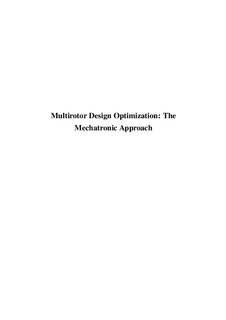| dc.contributor.author | Magnussen, Øyvind | |
| dc.date.accessioned | 2016-12-28T12:25:54Z | |
| dc.date.available | 2016-12-28T12:25:54Z | |
| dc.date.issued | 2015 | |
| dc.identifier.isbn | 978-82-7117-793-5 | |
| dc.identifier.issn | 1504-9272 | |
| dc.identifier.uri | http://hdl.handle.net/11250/2425872 | |
| dc.description | Doktorgradsavhandling ved Fakultet for teknologi og realfag, Universitetet i Agder, 2015 | nb_NO |
| dc.description.abstract | Multirotors such as the more famous quadcopter have been a favoured research object the last years. It is widely used as a flying platform for the hobby enthusiasts, but recently also used more and more by the industry. The multirotor has complex dynamics and requires sensors and a control system in order to fly. To get the desired flight characteristics batteries, motor and the propeller have to be chosen wisely as different combinations create different properties. The usual design approach is to test different combinations of motors and propellers, and based on experience select components that will be closest to the desired flight properties. This thesis presents an optimization method that calculates what hardware to use in order to get closest to the demanded properties. The method will only select from a given database, hence not returning a diameter and pitch of a propeller that are not available. A wide range of criteria can be optimized, examples are dynamics of the motor/propeller, flight dynamics, flight time, payload etc. The optimization routine will also calculate if the better choice is a quadcopter with four propellers, a hexacopter with six or an octocopter with eight propellers. The optimization is not trivial due to the non-linear characteristics of the propeller. A lot of experimental work was done to test the response of the propeller, both for acceleration and deceleration. Theory and experimental work show that the thrust response of the propeller can be more or less equal if the electronic speed controller controls the motor in a special mode. This mode also makes the response of the motor faster than normal. The new design is tested with a new approach for attitude estimation, and a controller operating directly with the result of the estimator. Most of the multirotors use a microcontroller with limited resources as the control system, hence the attitude and controller were designed specifically without time consuming trigonometric functions such as the sine and cosine. Overall, the methods and results presented in this thesis will aid the engineer when designing a multirotor system consisting of control system, mechanical frame, battery, actuators and propellers. | nb_NO |
| dc.language.iso | eng | nb_NO |
| dc.publisher | Universitet i Agder / University of Agder | nb_NO |
| dc.relation.ispartofseries | Doctoral dissertations at University of Agder; | |
| dc.rights | Navngivelse-Ikkekommersiell-DelPåSammeVilkår 4.0 Internasjonal | * |
| dc.rights.uri | http://creativecommons.org/licenses/by-nc-sa/4.0/deed.no | * |
| dc.title | Multirotor Design Optimization: The Mechatronic Approach | nb_NO |
| dc.type | Doctoral thesis | nb_NO |
| dc.type | Peer reviewed | nb_NO |
| dc.subject.nsi | VDP::Teknologi: 500 | nb_NO |
| dc.source.pagenumber | VIII, 188 | nb_NO |
| dc.source.volume | 107 | nb_NO |

